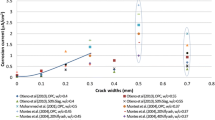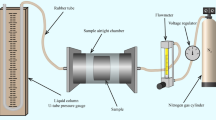Abstract
This study explores the chloride penetration characteristics of reinforced concrete (RC) hollow piles. Special splitting tests were designed to produce different crack widths in the inner and outer surfaces of RC hollow piles. The cracked specimens were then immersed in 5 % NaCl solution for 180 days. The chloride concentration profiles in the cracked zones were obtained by potentiometric titration. This study indicates that the rate of chloride accumulation in the inner pile surface is faster than that in the outer surface for the same exposure time. This may be attributed to differences in the material compositions of the inner and outer surfaces, which are caused by centrifugal processing during specimen preparation. The critical value for V-shaped cracks on the outer surface of RC hollow piles was found to be around 70 µm; however, a critical value was absent for cracks on the inner surface because these present parallel-wall characteristic. In addition, the characteristics of crack development and recovery in the inner and outer pile surfaces were evaluated. The analysis indicates that the depth at which chloride affects the concrete significantly increases with the crack-recovery rate for the apparent crack widths around 130 µm on the outer surface of the concrete layer.












Similar content being viewed by others
References
Shao W, Li J (2014) Service life prediction of cracked RC pipe piles exposed to marine environments. Constr Build Mater 64:301–307
Melchers RE, Li CQ (2009) Reinforcement corrosion initiation and activation times in concrete structures exposed to severe marine environments. Cement Concr Res 39(11):1068–1076
Yu H, Chiang K, Yang LT (2012) Threshold chloride level and characteristics of reinforcement corrosion initiation in simulated concrete pore solutions. Constr Build Mater 26(1):723–729
Hussain SE, AlGahtani AS, Rasheeduzzafar M (1996) Chloride threshold for corrosion of reinforcement in concrete. ACI Mater J 93(6):534–538
Chen D, Mahadevan S (2008) Chloride-induced reinforcement corrosion and concrete cracking simulation. Cement Concr Comp 30(3):227–238
Gowripalan N, Sirivivatnanon V, Lim CC (2000) Chloride diffusivity of concrete cracked in flexure. Cement Concr Res 30(5):725–730
Ismail M, Toumi A, Francois R, Gagne R (2008) Effect of crack opening on the local diffusion of chloride in cracked mortar samples. Cement Concr Res 38(8):1106–1111
Park S, Kwon S, Jung SH, Lee S (2012) Modeling of water permeability in early aged concrete with cracks based on micro pore structure. Constr Build Mater 27(1):597–604
Gerard B, Marchand J (2000) Influence of cracking on the diffusion properties of cement-based materials—Part I: influence of continuous cracks on the steady-state regime. Cement Concr Res 30(1):37–43
Aldea CM, Shah SP, Karr A (1999) Effect of cracking on water and chloride permeability of concrete. J Mater Civil Eng 11(3):181–187
Wang KJ, Jansen DC, Shah SP, Karr AF (1997) Permeability study of cracked concrete. Cement Concr Res 27(3):381–393
Jang SY, Kim BS, Oh BH (2011) Effect of crack width on chloride diffusion coefficients of concrete by steady-state migration tests. Cement Concr Res 41(1):9–19
Aldea C, Shah SP, Karr A (1999) Permeability of cracked concrete. Mater Struct 32(5):370–376
Djerbi A, Bonnet S, Khelidj A, Baroghel-Bouny V (2008) Influence of traversing crack on chloride diffusion into concrete. Cement Concr Res 38(6):877–883
Marsavina L, Audenaert K, Schutter G, Faur N, Marsavina D (2009) Experimental and numerical determination of the chloride penetration in cracked concrete. Constr Build Mater 23:264–274
Bentz DP, Garboczi EJ, Lu Y, Martys N, Sakulich AR, Weiss WJ (2013) Modeling of the influence of transverse cracking on chloride penetration into concrete. Cement Concr Comp 38:65–74
Park SS, Kwon SJ, Jung SH (2012) Analysis technique for chloride penetration in cracked concrete using equivalent diffusion and permeation. Constr Build Mater 29:183–192
Win PP, Watanabe M, Machida A (2004) Penetration profile of chloride ion in cracked reinforced concrete. Cement Concr Res 34(7):1073–1079
Boulfiza M, Sakai K, Banthia N, Yoshida H (2003) Prediction of chloride ions ingress in uncracked and cracked concrete. ACI Mater J 100(1):38–48
Huang IB, Yen SK (2002) Diffusion in hollow cylinders for some boundary conditions: I. Mathematical treatment. Mater Chem Phys 74(3):289–299
Carslaw H, Jaeger J, Feshbach H (1959) Conduction of heat in solids. Oxford University Press, London
Li J, Shao W (2014) The effect of chloride binding on the predicted service life of RC pipe piles exposed to marine environments. Ocean Eng 88:55–62
GB 13476-2009 (2009) Pretensioned spun concrete piles. TC S, Beijing
Ruan Q (2000) Prestressed concrete pipe pile. China Building Materials Press, Beijing
Sahmaran M, Li M, Li VC (2007) Transport properties of engineered cementitious composites under chloride exposure. ACI Mater J 104(6):604–611
Edvardsen C (1999) Water permeability and autogenous healing of cracks in concrete. ACI Mater J 96(4):448–454
Rodriguez OG, Hooton RD (2003) Influence of cracks on chloride ingress into concrete. ACI Mater J 100(2):120–126
GB/T 50476-2008 (2008) Code for durablity design of concrete structures. MOHURD, Beijing
Acknowledgments
This research was financially supported by the National Natural Science Foundation, China, with Grant No. 51178341. In addition, the authors greatly appreciate the reviewers for their valuable comments and suggestions in improving this paper.
Author information
Authors and Affiliations
Corresponding author
Rights and permissions
About this article
Cite this article
Yue, Z., Li, J., Shao, W. et al. Effect of crack opening and recovery on chloride penetration into reinforced concrete hollow piles. Mater Struct 49, 3217–3226 (2016). https://doi.org/10.1617/s11527-015-0714-3
Received:
Accepted:
Published:
Issue Date:
DOI: https://doi.org/10.1617/s11527-015-0714-3




